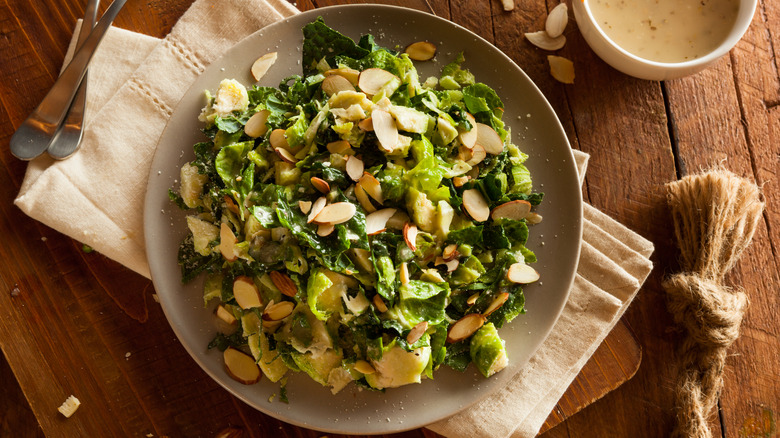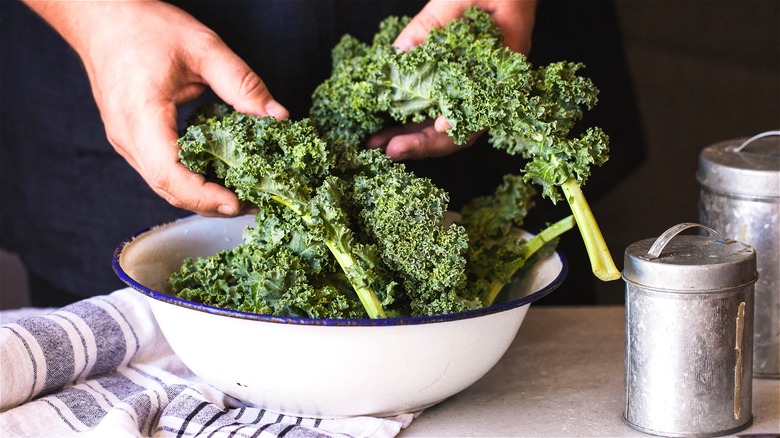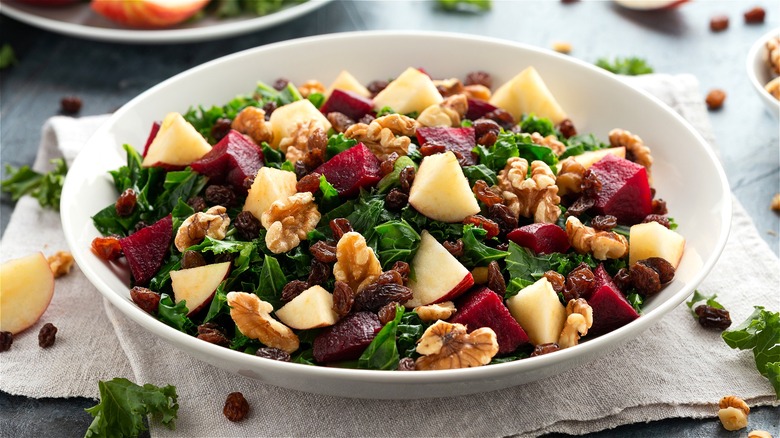Why Your Winter Salads Should Leave The Lettuce Behind
As colder weather becomes the norm this time of year, many people lean into their favorite satisfying wintertime dishes. And while no one can deny the robust flavors and belly-warming comfort of big meals like savory Sunday beef pot roast, or classic lasagna, sometimes you need a nice winter salad. For the best-tasting salads of the winter season, you may find ditching delicate, out-of-season produce for heartier crops is a good idea.
Thanks to greenhouse technology, lettuce types like Bibb, iceberg, and romaine are available throughout the year at grocery stores. But when it comes to making salads, those, and many other varieties that grow in warm temperatures, just don't provide those cozy winter vibes or flavors. If you're trying to encapsulate the best, most concentrated flavors of the winter season, you can craft delicious seasonal salads with colder-weather produce, heartier winter greens, and other ingredients like nuts and cheese.
For flavorful wintry salads, use heartier greens
If you're sad about leaving crisp lettuce behind during the cold season, consider all the hearty greens that thrive in chillier temperatures and ultimately make your seasonal salads taste better. The best winter salad recipes are often comprised of cruciferous vegetables or cold-weather greens such as kale, Swiss chard, arugula, and collard greens. The nutritional statistics aren't bad either. For example, according to Healthline, Brussels sprouts, which can be shaved to make a crunchy slaw, are high in fiber and vitamin K, while kale is rich in a very wide variety of vitamins and minerals.
Not only are seasonal greens nutritious, but they are also versatile in terms of preparation. If you're in the mood for a warm salad, greens like kale, radicchio, collards, and Swiss chard can be wilted, grilled, or sautéed. Peppery arugula, watercress, or spinach can satisfy all your fresh salad cravings. No matter what kinds of winter greens you choose, be sure to wash and dry them thoroughly. When choosing varieties like kale or collards to eat raw, just make sure to remove the thick inner stem (called the rib) from each leaf. Another plus is that eating in-season produce is often more cost-effective.
Winter greens pair well with bright and flavorful ingredients
Aside from winter greens, what separates a summer salad from a winter salad has everything to do with seasonal extras and personal taste preferences. Since dark leafy greens often have sharper flavors, pair these veggies with powerful sweet or savory ingredients to match their intensity. For example, make a bright, lemony salad dressing, or cook your greens with pancetta for an extra salty bite.
Since many winter-friendly greens can be served hot or cold, this is an opportunity to incorporate both in your salad. Roasted carrots and beets are tasty on top of dressed chopped kale with crunchy apple slices, for example. A bright pop of color and flavor from pomegranate, or orange segments, may provide just the right touch of sweetness.
When it comes to designing a delicious winter salad, opt for your favorite flavors, and try to incorporate a variety of textures. Think about using ingredients like roasted pecans, feta cheese, or homemade croutons. Just don't be afraid to experiment with the vast array of winter greens available.


